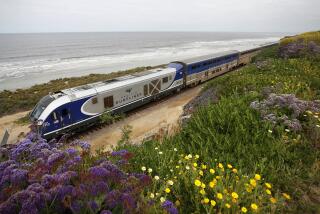Polyurethane Blocks May Provide a Sound Solution to Freeway Noise
- Share via
An experiment with plastic blocks made in Costa Mesa may give Caltrans the ability to build lighter, cheaper sound walls to tone down freeway traffic noise.
Bethel Lutheran Church in Encino is building a 13-foot-high wall of polyurethane blocks between the Ventura Freeway and the church and its school in the first use of the lightweight blocks for a sound wall in the United States, according to Caltrans and the block manufacturer, Canadian Insulock Corp.
Caltrans officials--who suggested that the church experiment with the blocks for them--said Monday that if the church’s wall works and proves sturdy enough, it may become a prototype for faster and cheaper construction of the sound walls that the state has been asked to build along freeways.
“If it works out fine, then our headquarters will be interested” in other applications, said Bill Minter, who oversees the placement and construction of sound walls for Caltrans in Los Angeles and Ventura counties.
Caltrans allowed the church to build the wall on state property in exchange for using the blocks, which received a U.S. patent last week. Total cost to the church will be about $65,000--about $85,000 less than had standard concrete blocks been used, said Kim Schafer, chairman of the church’s sound wall committee.
Amin J.A. Shivji, president of Canadian Insulock, said that using them can reduce the cost of building a wall 20% to 30%. If the blocks eventually become widely used, Minter said, they could free up money that would allow more sound walls to be built.
The yellow blocks are made of a material that resembles plastic foam packing materials. They are about the same size as 35-pound concrete blocks, but they weigh only 2 ounces. They lock together much like children’s toy building blocks, without mortar. When reinforced with concrete and metal rods, as they will be for the church’s sound wall, the blocks are as strong as standard blocks, Shivji said.
Steel reinforcing rods are placed through holes in the blocks that connect with steel rods in a concrete foundation. Concrete is poured into the hollow blocks to add strength. To protect the plastic from damage by the sun, the wall will be coated with stucco, Shivji said.
The church had tried for several years to persuade Caltrans to build a sound wall at the back of its property, which abuts the westbound lanes of the Ventura Freeway near the Sepulveda Basin. However, Caltrans had renovated the school’s classrooms to muffle freeway sounds and had installed air conditioning in 1978, and it was therefore under no obligation to pay for further improvements.
More to Read
Sign up for Essential California
The most important California stories and recommendations in your inbox every morning.
You may occasionally receive promotional content from the Los Angeles Times.









